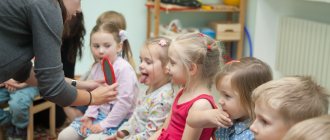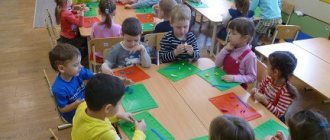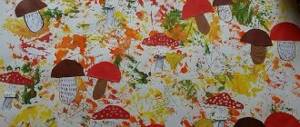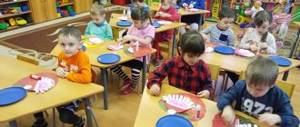Binary lesson in preschool educational institution article on the topic
1 slide
Speech at the city methodological association
«
Binary occupation in the light of the implementation of new standards in preschool educational institutions"
Recently, the Russian education system has been undergoing constant changes. Modernization of the learning process steadily leads every teacher to the understanding that it is necessary to look for such pedagogical technologies that could interest students and motivate them to study the subject. How can we make sure that our children, not under pressure, but through play, can discover new knowledge, evaluate their work and, ultimately, show good results? How to make sure that every child feels comfortable, interesting and at the same time understandable in a lesson (an exciting activity) or at any other event? How to harmoniously weave gaming moments into the outline of the lesson? How to choose one or another method for any stage of the lesson in order to achieve maximum results?
Today, teaching methods, like everything else in the country, are going through a difficult period. The goals of preschool education have changed, new curricula are being developed, new approaches to reflecting content through not separate isolated areas, but through integrated educational areas.
The renewal of education requires the use of non-traditional methods and forms of organization of learning, including integrative ones, as a result of the use of which the child develops a holistic perception of the world, and precisely the activity-based approach to learning that we must adhere to is formed.
Integration – (lat. Integratio
2 slide
A binary lesson is one of the forms of integration of subjects and the implementation of interdisciplinary connections. The main goal of a binary lesson is the systematization and generalization of existing knowledge, the formation of a holistic perception of the material being studied. First of all, this is a non-traditional type of lesson, in the preparation and implementation of which either two or maybe three teachers participate. A binary educational lesson is a lesson in the preparation of which teachers jointly plan the forms and methods of work, both their own and those of the students, but each teacher conducts his part of the educational lesson autonomously. The topic of the training session (both integrated and binary) is formulated based on the possibilities of the general content of the training programs implemented by these teachers. Monotonous, boring, monotonous classes - in a binary lesson they become interesting and exciting, children are active throughout the entire lesson.
3 slide
Goals of binary training sessions The main goal of a binary lesson is the systematization and generalization of existing knowledge, the formation of a holistic perception of the material being studied.
| For children | For teachers |
| Development of creative, imaginative thinking of children, the ability to apply acquired knowledge in a new situation Formation of a holistic worldview Expanding your horizons | More efficient use of study time Increasing motivation to study educational fields Opportunity for personal professional growth Development of cooperation between teachers |
4 slide
Stages of preparing a binary lesson
- choosing a topic for a lesson, analyzing factual material that can serve as a topic for a binary lesson. The idea of the lesson is very important!
- formulating lesson goals
- selection of content, formulation of main problems, key ideas of the lesson, concepts, meanings
- searching for the most rational form of training
- collaborative, careful planning. The lesson is divided into complementary parts
- writing a joint lesson note
- thinking through risks and restrictions
5 slide
It is more appropriate to integrate the areas “Cognition and Physical Culture”; “Cognition (mathematics) and artistic creativity”; “music and cognition”, “Artistic creativity and music”; “Communication and art. creativity”, “Socialization and artistic creativity” and others.
6 slide
- Firstly, the pedagogical efforts of two teachers are combined, which makes it possible to conduct professional training at a high level, because
the advantages of one are complemented by the advantages of the other. The existing shortcomings in the activities of one are compensated by the advantages of the other. Secondly, combining the efforts of two teachers helps to strengthen the management of the process of cognitive and practical activity (especially when the group is large). - Thirdly, strengthening the individuality of learning allows us to identify those children who need special attention.
Fourthly, it makes it easier to study complex topics. These classes are of great importance in terms of improving the qualifications of teachers themselves and their professional orientation.Fifthly, increasing the motivation and interest of children, attention is maintained at a high level
An unconventional approach to studying educational material, the form of the lesson is exciting and non-standard
Sixth - saving study time
Such activities will allow you to use variety:
— forms of organizational activity;
— teaching methods;
— control systems.
7 slide
With binary training, a comprehensive combination of various teaching methods is provided: dialogical, target orientation, motivational, communicative, control, analysis, improvement, they can alternate. With binary training, the presentation of new material is not canceled, it has a different form and should not be dissolved in practical action, but on the contrary - to be systematized, forming an integral system on a particular topic.
8 slide
The organization of binary training requires corresponding multifaceted work. When switching to binary training, the curricula and programs that guide our work can be used in full, but with the additions of a binary summary thematic plan, i.e. The topics of programs that are binary are clarified.
Slide 9
Integration results for an educational institution: Adequacy of modern requirements of education and upbringing; Combining the efforts of different specialists in solving common problems; Wide choice of activities; The emergence of new development prospects; Obtaining high-quality pedagogical results.
Recommendations: To successfully conduct integrated classes, it is necessary: systematically conducting integrated classes once a week. The teacher’s passion and awareness of the importance of the problem. incubation of a plan, during which further development of content takes place. selection of technical equipment.
10 slide
CONCLUSION
Thus, binary classes have enormous educational potential, form a belief in the connectedness of objects and the integrity of the world, and allow you to integrate knowledge from different areas to solve one problem. These classes provide an opportunity to activate students’ thinking and apply the acquired knowledge in practice.
Binary classes allow you to develop collaboration between teachers. To conduct such a lesson, you need to “tinker,” but as Sukhomlinsky said: “A teacher prepares for a good lesson all his life... This is the spiritual and philosophical basis of our profession and the technology of our work: in order to open a spark of knowledge to children, the teacher needs to absorb a sea of light, neither without leaving for a moment the rays of the ever-shining sun of knowledge, human wisdom.”
Binary lessons are one of the forms of implementing interdisciplinary connections and integration of subjects.
Binary lessons are one of the forms of implementing interdisciplinary connections and integration of subjects.
Esaulkova O.V., teacher of computer science and ICT,
OGAPOU "Stary Oskol Medical College"
Today in Russia, in connection with the introduction of new generation standards, it is planned to move away from excessive theorizing in studying and transition to a practice-oriented approach, allowing graduates to obtain information about the world around them from the point of view of interaction between the individual, society and the state.
Each teacher organizes his teaching activities in such a way as to attract students’ attention to his subject and arouse their interest. Methodological mastery today is determined by the compliance of the following elements:
1) variability of approaches to teaching the subject
2) a combination of different teaching strategies
3) individuality of approaches
4) the ability to focus on expected results and understand goals.
Currently, the concept of pedagogical technology has firmly entered the pedagogical lexicon. Any modern pedagogical technology is a synthesis of the achievements of pedagogical science and practice, a combination of traditional elements of past experience and modern pedagogical experience.
The solution of these problems in vocational education is facilitated by interactive, integrated, project-based, problem-based, and modular learning technologies. An integral part of modern pedagogical technologies is the form of organization of training.
A few words from the history of educational technologies.
An integrated lesson is a training session in which a designated topic is examined from different points of view, using several subjects (courses). It can be carried out by one or several people.
The task of integration is not just to show the areas of contact between several academic disciplines, but through their organic, real connection to give students an idea of the unity of the world around them. Integrated lessons require the mandatory development of students’ creative activity, develop potential, encourage active knowledge of the surrounding reality, to comprehend and find cause-and-effect relationships, and to develop personality. The structure of integrated lessons is clarity, compactness, conciseness, logical interdependence of educational material at each stage of the lesson, large informative capacity of the material.
The advantages of a multi-subject integrated lesson over a traditional single-subject lesson are obvious. In such a lesson, more favorable conditions can be created for the development of a wide variety of intellectual skills of students, through it one can develop broader synergetic thinking, teach the application of theoretical knowledge in practical life, in specific life, professional and scientific situations. Integrated lessons bring the learning process closer to life, naturalize it, enliven it with the spirit of the times, and fill it with meaning.
Within the framework of integrated educational technology, the most interesting are binary lessons based on interdisciplinary connections, since they involve the use of a fusion of various pedagogical technologies.
Binary lessons are one of the forms of implementing interdisciplinary connections and integration of subjects. This is a non-traditional type of lesson. A lesson on a topic is taught by two or more subject teachers.
In binary lessons, you can combine seemingly incompatible subjects, for example, mathematics and English.
Binary lessons require a lot of preparation, both for teachers and students. This is the creativity of two teachers, which develops into a creative process among students. Why? Because studying a certain problem at the intersection of two sciences is always interesting, this type of activity causes high motivation. Isn’t this the main thing – to captivate students and provoke creative search?
This new phenomenon in the classroom system is rather an exception to the rule. They are not used often. It is difficult to combine them with the curriculum of two or three subjects, and difficulties arise with the schedule. And it takes more time to prepare such a lesson than usual. Contraindications in the use of binary lessons are inconsistency and incompatibility of teachers.
Methodology for conducting binary lessons
The purpose of a binary lesson is to create conditions for the motivated practical application of knowledge, skills and abilities, the formation of universal educational actions, i.e. give students the opportunity to see the results of their work and get joy and satisfaction from it. The development of learning motives is a necessary indicator of the formation of a student’s internal position.
To prepare a binary lesson, you need your own specific system.
Forms of conducting a binary lesson:
- lesson-lecture;
- lesson-seminar;
- test lesson;
- lesson-press conference;
- lesson-practical work;
- travel lesson;
- lesson-research;
- lesson-meeting of the editorial board;
- lesson creative report;
- lesson-quiz;
- lesson-competition;
- lesson project;
- lesson on working with ESM,
- simulation based lesson.
Methods for conducting binary lessons:
- visual transmission and visual perception;
- stimulation and motivation;
- problem-search;
- research.
Teaching methods:
- conversation;
- discussion;
- observation;
- demonstration;
- frontal, group or individual survey;
- practical work.
But in addition, a modern binary lesson is a form of project. Usually this is an interdisciplinary internal short-term or medium-duration project. Such lessons allow you to integrate knowledge from different fields to solve one problem, and provide an opportunity to apply the acquired knowledge in practice.
The lesson is divided into complementary parts, and duplication must be avoided. A research problem is put forward, the group is divided into creative groups that search for information, facts and arguments necessary to conduct the research and present the results.
Binary lessons are conducted at the stage of creative application of the studied material; in such lessons, interesting, practically significant and accessible problems for students are solved on the basis of intercultural interaction. The results of the study are presented in the form of presentations, tables, opinion polls, work with microscopes and microslides, videos that have practical value, which can later be used as teaching material.
Binary lessons create conditions for the practical application of knowledge, systematize knowledge, develop self-education skills, since students prepare for the lesson independently, they search for information, facts, arguments necessary for conducting research and presenting the results. All this develops their analytical abilities, ingenuity, and activates mental activity.
The procedure for preparing binary lessons:
1st stage. An analysis of educational material from two or more disciplines is carried out in order to determine a common topic that will be the basis of such a lesson.
2nd stage. Joint careful planning by teachers of the course of the lesson, in which the role of each of them will be clearly defined. You need to know that such a lesson should consist of complementary, but not duplicating parts from different subjects.
3rd stage. Summarizing. Assessing and recording student performance results.
Binary or integrated? Difference.
A binary lesson is a type of integrated lesson; it is taught by two teachers, while an integrated lesson can be taught by one or several teachers.
In a binary lesson, more complex problems :
- the horizons of students and teachers expand;
- integrates knowledge from different fields;
- contributes to the formation in students of a belief in the coherence of objects and the integrity of the world;
- serves as a means of increasing motivation to study subjects, since it creates conditions for the practical application of knowledge;
- develops self-education skills in students, because students can partially prepare for a lesson independently and outside of class time;
- develops analytical skills and ingenuity;
- has enormous educational potential;
- Allows students to make decisions in creative situations.
This is a higher level of cooperation between two teachers, as well as between teachers and students. The main point of a binary lesson is to prepare a person for independent practical activity.
The experience of conducting binary lessons shows that preparing and conducting binary lessons helps improve the professional competencies of teachers and the formation of an adequate student assessment of the significance of the disciplines being studied for future professional activities.
A binary lesson is the highest form of implementation of new educational standards, because allows you to achieve meta-subject results and improve students’ meta-subject competencies.
Binary lesson. What's happened
When designing a modern lesson, various forms and methods of organizing teaching are increasingly used.
Therefore, the modern lesson, while retaining its inherent characteristics, is at the same time considered not only as a variable, but also as a constantly developing form. The main direction of this development is seen in the desire to ensure that the lesson becomes the result of creativity not only of the teacher, but also of the students.
One of the directions in achieving this goal may be to conduct binary lessons.
The word "binary" comes from the Latin word "bis".
A binary lesson is a non-traditional form of teaching. Its structure organically combines the personalities of the teacher and the specialist teacher, their interaction with each other, as well as with students.
The binary lesson methodology differs from the traditional one in that the teacher and specialist teacher simultaneously teach a lesson on some final topic.
It is known that when conducting traditional lessons in various subjects, students’ perception of new information in each academic discipline does not form a coherent system. As a result, schoolchildren cannot quickly apply knowledge of one subject when studying another, as well as productively use it when solving complex problems. In the case of simultaneous consideration of program material within two academic subjects, the information received acquires practical significance, and the assimilation of new knowledge occurs as if by superimposing it on basic knowledge and skills.
A binary lesson allows you to identify the connection between different subjects and makes learning holistic and systematic. Conducting binary lessons requires special careful preparation from teachers. Such lessons can be successful only if both teachers work together in a coordinated creative manner.
What can a binary lesson teach? Naturally, the quality of consolidation of the studied material, better assimilation of educational elements, increased interest in subjects and much more, which depends on the immediate goals of a particular lesson.
Thus, the binary lesson technology allows you to transfer theory into practice, and raise the formation of skills and abilities to the level of meaningful, educational activity. At the same time, a unified approach to the consideration of emerging problems and unity of requirements for students in the process of their educational activities is achieved.
Under the influence of interest caused by the communication of the triangle “teacher - teacher-specialist - students,” the perception of educational material proceeds more actively, observation becomes sharper, emotional and logical memory is activated, and the imagination works more intensely. A binary lesson develops in students the ability to use theoretical knowledge in a variety of ways, in non-standard situations.
Binary lessons, without a doubt, enliven the educational process, develop the cognitive interest of schoolchildren, contribute to the development of the child’s personality, and provide an opportunity to increase learning motivation.
The binary teaching model is an important means of implementing intra-subject and inter-subject connections; it is also an integrated teaching tool that helps solve many problems, as well as organize correctional support for students.







